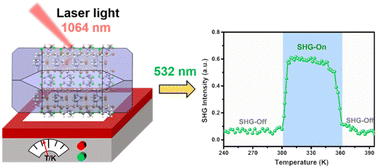Thermally-driven unusual dual SHG switching with wide SHG-active steps triggered by inverse symmetry breaking†
Abstract
Solid nonlinear optical (NLO) materials with switchable second-harmonic generation (SHG) on/off states show strong potential applications in photo-electronic devices. A sustained progress has been made through the persistent exploration of NLO materials, and numerous switchable crystals viewed as single-step SHG switching have been reported. However, the multi-step switching with SHG “off–on–off” states has rarely been reported, which severely restricts the development of novel NLO sensors and lasers. Herein, we report an organic–inorganic hybrid crystal with unconventional two-step SHG transitions. It shows excellent high contrast “off–on–off” SHG conversion in the range of around room temperature. Most notably, its SHG-active state covers a wide temperature range from 304 to 354 K, which is superior to most unconventional SHG switches. The structure–activity relationship analysis shows an unusual symmetry reduction feature triggered by molecular motion, that is, the dual centro–noncentro–centrosymmetric transition, producing unusual two-step SHG switching. This study will promote the diversified development of switchable NLO materials.



 Please wait while we load your content...
Please wait while we load your content...